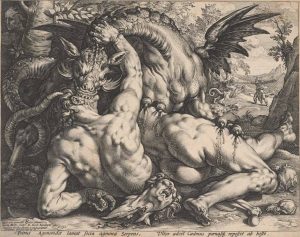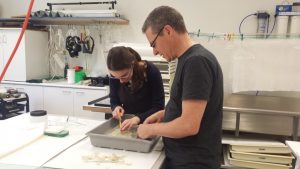Conserving the Baillieu’s dragon
Funding from the Miegunyah Bequest enabled the Baillieu Library’s most requested work of art, The Dragon Devouring the Companions of Cadmus (c.1588), to be conserved. Treatment was carried out by paper conservators Peter Mitchelson and Adele Barbara, who explain this intricate process.

While Hendrick Goltzius’ 16th century engraving, The Dragon Devouring the Companions of Cadmus, arrived to the laboratory in a good condition for its age, a thorough conservation treatment was required to bring the print back to its former glory.
The print itself was mounted onto acidic backing board, which prevented access to the back of the work and was potentially a catalyst for degradation into the future. Edges of white paper visible along an edge of the print indicated that it had also been lined in the past to repair tears and strengthen the work. In order to discover what was hidden behind these layers, and allow the print to be repaired and cleaned effectively, these backings had to be removed.
To remove the mount board backing, the engraving was placed face down on a flat, even surface. As the support was adhered in all four corners, most of the board could be cut away. What remained was carefully pared back with a scalpel. Beneath this backing, however, another layer or partially removed backing, with the hint of an inscription showing through, was uncovered. This backing differed from the first in that it had mostly been removed. Due to the presence of an inscription, though, it was decided that these final layers had to be removed. A poultice of methylcellulose was used to gently moisten the remainder of the backing before it could be carefully scraped away.
Once this final layer was removed, the lining paper adhered to the back of the work could then be considered. After trialling the use of a high-pressure steamer to remove the lining with little success, testing was conducted investigate what was adhering the lining so strongly to the back of the print. Spot testing using a potassium iodide solution revealed that a starch-based adhesive was used during the previous treatment. Consequently, it was decided that the most effective way of removing the lining would be while both the lining and the print were wet.

To achieve this, the print was placed in a bath of warm deionised water face down. Using soft brushes and hand tools, we were gradually able to carefully peel back small sections of the lining until it was completely removed. After the lining was removed, however, a sticky residue remained behind. To quickly remove the adhesive before the print dried, the back of the work was carefully swabbed with small cotton swabs.
Once this process had been completed, the print could then be thoroughly washed in deionised water. This process allowed for any remaining dirt or degradation products to be released, stabilising and cleansing the print. Once washed, the print was flattened to allow for repairs to be made to the tear on the front of the work.
During the removal of the lining, a historic infill was removed from the top right corner of the work. We have selected to retain the original fill, but will instead secure it with discreetly with Japanese tissue.
Once the repairs are complete and the engraving is mounted, The Dragon Devouring the Companions of Cadmus may return to the Baillieu Library Print Collection to be displayed and enjoyed for years to come.
Adele Barbara, Paper Conservator
The Grimwade Centre for Cultural Materials Conservation
Leave a Reply